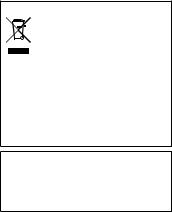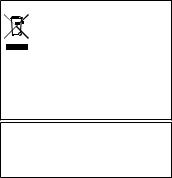Olympus M.Zuiko digital ED 100-400mm 5.0-6.3 IS Manual

|
|
|
|
|
|
|
|
|
|
|
|
|
|
|
|
|
|
|
|
date of issue 2020.01 |
ED 100-400mm f5.0-6.3 IS |
||
© 2020 |
|
WD681300 |
Model No.:IM022 |
||
|
Printed in Japan |
||||
|
|
|
|
||
04 |
- |
JP |
|
80 |
- |
PL |
INSTRUKCJA |
08 |
- |
EN |
INSTRUCTIONS |
84 |
- |
PT |
INSTRUÇÕES |
13 |
- |
FR |
MODE D’EMPLOI |
88 |
- |
RO |
INSTRUCŢIUNI |
18 |
- |
ES |
INSTRUCCIONES |
92 |
- |
RU |
ИНСТРУКЦИЯ |
22 |
- |
DE |
BEDIENUNGSANLEITUNG |
97 |
- |
SK |
NÁVOD NA POUŽITIE |
27 |
- |
BG |
ИНСТРУКЦИИ |
101 |
- |
SL |
NAVODILA |
31 |
- |
CS |
NÁVOD K POUŽITÍ |
105 |
- |
SR |
UPUTSTVO ZA UPOTREBU |
35 |
- |
DA |
BETJENINGSVEJLEDNING |
109 |
- |
SV |
BRUKSANVISNING |
39 |
- |
EL |
ΟΔΗΓΙΕΣ |
113 |
- |
TR |
TALİMATLAR |
44 |
- |
ET |
JUHISED |
117 |
- |
UK |
ІНСТРУКЦІЯ |
48 |
- |
FI |
KÄYTTÖOHJEET |
124 |
- |
AR |
|
52 |
- |
HR |
UPUTE |
125 |
- |
CHT |
|
56 |
- |
HU |
HASZNÁLATI ÚTMUTATÓ |
128 |
- |
KR |
|
60 |
- |
IT |
ISTRUZIONI |
131 |
- |
TH |
|
64 |
- |
LT |
INSTRUKCIJA |
134 |
- |
VI |
CÁC HƯỚNG DẪN |
68 |
- |
LV |
NORĀDĪJUMI |
|
|
|
|
72 |
- |
NL |
AANWIJZINGEN |
|
|
|
|
76 |
- |
NO |
INSTRUKSJONER |
|
|
|
|

JP
8IS
0
AF/MF
4 JP
IS
ON
OFF
リングの目盛りを「100
LOCK
1
2
3
1
23
The following importer description applies to products imported into the EU directly by OLYMPUS EUROPA SE & Co. KG only. OLYMPUS EUROPA SE & Co. KG
Wendenstrasse 14-18, 20097 Hamburg, Germany Manufactured by OLYMPUS CORPORATION
2951 Ishikawa-machi, Hachioji-shi, Tokyo 192-8507, Japan
141
|
|
|
|
• |
|
: |
|
|
|
: 100 400 mm |
|
|
|
(35 mm |
|
|
|
200 800 mm) |
|
|
|
: F5.0 |
|
• 2 |
|
: 12° 3.1° |
|
|
|
: 15 21 |
|
|
|
: F5.0 22 |
|
• |
|
: 1.3 m ) ( ) |
|
|
: AF/MF |
||
• |
|
: 1,120 g |
|
|
|
|
|
• |
× : φ86.4× 205.5 mm |
||
|
|
: |
|
• |
: φ 72 mm |
||
|
M.ZUIKO |
||
|
|||
|
|||
|
|||
|
|||
|
|
||
|
|
|
|
|
|
||
|
|
||
JP 5


Micro Four Thirds Micro Four Thirds
6 JP
URL software notice PDF
http://www.olympus.co.jp/en/support/imsg/
digicamera/download/notice/notice.cfm
www.tron.org
μT-License μT-Kernel
JP 7
 INSTRUCTIONS
INSTRUCTIONS
Thank you for purchasing this Olympus product. To ensure your safety, please read this instruction manual before use, and keep it handy for future reference.
Names of parts
1 Lens hood
2 Focus ring
3 Zoom ring
4 Zoom lock switch
5 Mount index
6 Focus limiter switch
7 Focus mode switch
8 IS switch
9 Electrical contacts
0 Tripod mount
Focus mode switch
Switches between AF/MF.
Focus limiter switch
Sets the range of the photographing distance. Focusing is done within the range that is set.
IS switch
ON: The stabilizing function of the lens operates.
OFF: The stabilizing function of the lens is off. The stabilizing function of the camera operates according to the setting on the camera. If you do not want to use the stabilizing function, disable the function on both the camera and the lens.
Zoom lock switch
Prevents inadvertent extension of the lens. Set the dial of the zoom ring to “100”, and set the zoom lock switch to the “LOCK” position.
Attaching the hood (Fig. 1)
Storing the hood (Fig. 2)
Removing the tripod mount (Fig. 3)
Turn the knob of the tripod mount to loosen it 1. Turn the tripod mount in the direction of the arrow, align it with the mark 2, and remove it from the lens body 3.
8 EN
Notes on Shooting
•Please use the latest firmware for the camera. Operations will vary depending on the camera. For more information, please visit our home page. Contact the other manufacturer to mount the lens on another manufacturer’s digital camera.
•Edges of pictures may be cut off if more than one filter is used or if a thick filter is used.
•When using a flash, flash light may be blocked by the lens body, lens hood, etc.
•Usage conditions may lower the number of images that can be captured.
•Do not hold only the camera body without holding the lens. The waterproofing characteristic or optical performance may not be maintained.
•Do not touch electric contacts on cameras.
Maintenance
Blow dust off the lens with a commercially available blower. For the lens, wipe gently with a lens cleaning paper. Mold may form on the lens surface if the lens is left dirty.
Main Specifications
Mount |
: Micro Four Thirds mount |
Focal distance |
: 100 – 400 mm (equivalent |
|
to 200 to 800 mm on a |
|
35 mm camera) |
Max. aperture |
: f5.0 |
Image angle |
: 12° – 3.1° |
Lens configuration |
: 15 groups, 21 lenses |
Iris control |
: f5.0 to f22 |
Shooting range |
: 1.3 m (51.2 in.) to ) |
|
(infinite) |
Focus adjustment |
: AF/MF switching |
Weight |
: 1,120 g (39.5 oz.) |
|
(excluding hood, cap and |
|
tripod mount) |
Dimensions |
: Max. dia. Ø 86.4 (3.4 in.) × |
|
length 205.5 mm (8.1 in.) |
Lens hood |
: Bayonet |
Filter mount thread diameter : Ø 72 mm
This lens can be used with an M.ZUIKO teleconverter. For more information on compatible teleconverters and notes on combining them with the lens, please visit our home page.
EN 9

*Specifications are subject to change without any notice or obligation on the part of the manufacturer.
Precautions: Be Sure to Read the Following  Warnings: Safety Precautions
Warnings: Safety Precautions
•Do not view the sun through the lens. It may cause blindness or vision impairment.
•Do not leave the lens without the cap. If solar light is converged through the lens, a fire may result.
•Do not point the camera lens at the sun. Sunlight will converge in the lens and focus inside the camera, possibly causing a malfunction or fire.
Micro Four Thirds and the Micro Four Thirds logo are trademarks or registered trademarks of OLYMPUS CORPORATION.
Olympus will not be held liable for violations of local regulations arising from use of this product outside the country or region of purchase.
FCC Notice
This equipment has been tested and found to comply with the limits for a Class B digital device, pursuant to part 15 of the FCC Rules. These limits are designed to provide reasonable protection against harmful interference in a residential installation. This equipment generates, uses
and can radiate radio frequency energy and, if not installed and used in accordance with the instructions, may cause harmful interference to radio communications. However, there is no guarantee that interference will not occur in a particular installation. If this equipment does
cause harmful interference to radio or television reception, which can be determined by turning the equipment off and on, the user is encouraged to try to correct the interference by one or more of the following measures:
•Reorient or relocate the receiving antenna.
•Increase the separation between the equipment and receiver.
•Connect the equipment into an outlet on a circuit different from that to which the receiver is connected.
•Consult the dealer or an experienced radio/TV technician for help.
•Only the OLYMPUS-supplied USB cable should be used to connect the camera to USB enabled personal computers.
10 EN

FCC Caution
Changes or modifications not expressly approved by the party responsible for compliance could void the user’s authority to operate the equipment.
For customers in North America, Central America, South America and the Caribbean
Declaration of Conformity
Model Number |
: IM022 |
||
Trade Name |
: OLYMPUS |
||
Responsible Party |
: |
|
|
|
|
||
Address |
: 3500 Corporate Parkway, P. O. Box 610, Center Valley, PA 18034-0610, USA |
||
Telephone Number |
: 484-896-5000 |
|
|
Tested To Comply With FCC Standards FOR HOME OR OFFICE USE
This device complies with part 15 of the FCC Rules. Operation is subject to the following two conditions:
(1)This device may not cause harmful interference, and
(2)this device must accept any interference received, including interference that may cause undesired operation.
CAN ICES-3(B)/NMB-3(B)
EN 11

 Technical Support (U.S.A. / Canada)
Technical Support (U.S.A. / Canada)
24/7 online automated help : http://www.olympusamerica.com/support Phone customer support : Tel.1-800-260-1625 (Toll-free)
Our phone customer support is available from 9 am to 9 pm (Monday to Friday) ET
E-Mail : distec@olympus.com
For customers in Europe
This symbol [crossed-out wheeled bin WEEE Annex IV] indicates separate collection of waste electrical and electronic equipment in the EU countries.
Please do not throw the equipment into the domestic refuse.
Please use the return and collection systems available in your country for the disposal of this product.
• European Technical Customer Support
Please visit our homepage http://www.olympus-europa.com
or call: Tel. 00800 - 67 10 83 00 (Toll-free) +49 40 - 237 73 899 (Charged)
The software in this lens may include third party software. Any third party software is subject
to the terms and conditions, imposed by the owners or licensors of that software, under which software is provided to you.
Those terms and other third party software notices, if any, may be found in the software notice PDF file stored at http://www.olympus.co.jp/en/support/imsg/ digicamera/download/notice/notice.cfm
This product uses μT-Kernel source code under the terms of the TRON Forum (www.tron.org) μT-License.
12 EN
 MODE D’EMPLOI
MODE D’EMPLOI
Nous vous remercions pour l’achat de ce produit Olympus.
Pour votre sécurité, veuillez lire ce mode d’emploi avant utilisation et conserver ces instructions à portée de main pour un usage ultérieur.
Noms des pièces
1Pare-soleil
2Bague de mise au point
3Bague de zoom
4Commutateur de verrouillage du zoom
5Repère de montage
6Commutateur du limiteur de mise au point
7Commutateur du mode de mise au point
8Commutateur IS
9Contacts électriques
0 Fixation du trépied
Commutateur du mode de mise au point
Commutateur entre AF/MF.
Commutateur du limiteur de mise au point
Définit la plage de la distance de la prise de vue. La mise au point est effectuée dans la plage définie.
Commutateur IS
ON : La fonction de stabilisation de l’objectif est active.
OFF : La fonction de stabilisation de l’objectif est inactive. La fonction de stabilisation de l’objectif agit selon le réglage défini sur l’appareil photo. Si vous ne voulez pas utiliser la fonction de stabilisation, désactivez-la sur l’appareil photo et sur l’objectif.
Commutateur de verrouillage du zoom
Évite toute extension accidentelle de l’objectif. Réglez la molette de la bague de zoom sur
« 100 », puis positionnez le commutateur de verrouillage sur « LOCK ».
Fixation du pare-soleil (fig. 1)
Rangement du pare-soleil (fig. 2)
Retrait de la fixation du trépied (fig. 3)
Tournez le pommeau de la fixation du trépied pour le desserrer 1. Tournez la fixation du trépied dans le sens de la flèche, alignez-la sur le repère 2 et enlevez-la du corps de l’objectif
3.
FR 13
Remarques sur la prise de vue
•Veuillez utiliser la version la plus récente du micro-logiciel pour l’appareil photo. Le fonctionnement varie selon l'appareil photo. Pour plus d’informations, veuillez consulter notre page d’accueil. Contactez l’autre fabricant concerné pour monter l’objectif sur un appareil photo numérique d’un autre fabricant.
•Les bords des images risquent d’être coupés si plusieurs filtres sont utilisés ensemble ou si vous utilisez un filtre épais.
•Lors de l’utilisation du flash, la lumière du flash peut être stoppée par l’objectif, le pare soleil, etc.
•Les conditions d’utilisation peuvent réduire le nombre d’images pouvant être prises.
•Ne tenez pas le boîtier de l’appareil photo sans tenir l’objectif. Les caractéristiques de résistance à l’eau ou les performances
optiques risquent de ne pas être maintenues.
•Ne touchez pas les contacts électriques des appareils photo.
Entretien
Éliminez la poussière de l’objectif à l’aide d’une soufflette disponible dans le commerce. Pour l’objectif, essuyez-le délicatement avec du papier nettoyant pour objectif. De la moisissure peut se former sur la surface de l’objectif si la saleté n’est pas éliminée.
Caractéristiques principales
Fixation |
: fixation avec micro Four |
|
|
|
Thirds |
Longueur focale |
: |
100 à 400 mm (équivalent |
|
|
à 200 à 800 mm sur un |
|
|
appareil photo 35 mm) |
Ouverture maximale: |
f5,0 |
|
Angle de vue |
: 12° – 3.1° |
|
Configuration de |
|
|
l’objectif |
: |
15 groupes, 21 lentilles |
Commande de |
|
|
diaphragme |
: |
f5,0 à f22 |
Plage de prise |
|
|
de vue |
: |
1,3 m à )(infini) |
Réglage de |
|
|
la mise au point |
: Commutation AF/MF |
|
14 FR
Poids |
: 1 120 g |
|
(pare-soleil, capuchon et |
|
fixation du trépied exclus) |
Dimensions |
: Dia. max. Ø 86,4 × |
|
longueur 205,5 mm |
Pare-soleil |
: Baïonnette |
Diamètre de filetage |
|
du montage du filtre : Ø 72 mm |
|
Cet objectif peut être utilisé avec un téléconvertisseur M.ZUIKO. Pour plus d’informations sur les téléconvertisseurs compatibles et pour lire des notes sur la manière de les associer à l’objectif, veuillez consulter notre page d’accueil.
*Caractéristiques modifiables sans préavis ni obligations de la part du fabricant.
Précautions : Bien lire la suite  Avertissements : précautions de sécurité
Avertissements : précautions de sécurité
•Ne pas regarder le soleil à travers l’objectif. Cela pourrait causer des troubles ou la perte de la vue.
•Ne pas laisser l’objectif sans le bouchon. Si des rayons du soleil sont concentrés à travers l’objectif, un incendie risque de se produire.
•Ne pas pointer l’objectif monté sur l’appareil vers le soleil. Les rayons du soleil seraient concentrés dans l’appareil photo, pouvant provoquer un mauvais fonctionnement ou un incendie.
Micro Four Thirds et le logo Micro Four Thirds sont des marques commerciales ou déposées de OLYMPUS CORPORATION.
Olympus ne sera pas tenu responsable des violations des réglementations locales résultant de l’utilisation de ce produit en dehors du pays ou de la région d’achat.
FR 15

Pour les utilisateurs en Amérique du Nord, Amérique Centrale, Amérique du Sud et aux Caraïbes
CAN ICES-3(B)/NMB-3(B)
 Support technique (États-Unis / Canada)
Support technique (États-Unis / Canada)
Aide en ligne 24/24h, 7/7 jours : http://www.olympusamerica.com/support Ligne téléphonique de support :
Tél. 1-800-260-1625 (appel gratuit)
Notre centre d’appels clients est ouvert de 9 h à 21 h (du lundi au vendredi) Heure de l’Est Email : distec@olympus.com
Pour les utilisateurs en Europe
Le symbole [poubelle sur roue barrée d’une croix WEEE annexe IV] indique une collecte séparée des déchets d’équipements électriques et électroniques dans les pays de l’UE. Veuillez ne pas jeter l’équipement dans les ordures domestiques.
A utiliser pour la mise au rebut de ces types d’équipements conformément aux systèmes de traitement et de collecte disponibles dans votre pays.
• Support technique européen
Visitez notre site à l’adresse http://www.olympus-europa.com ou appelez le :
00800 - 67 10 83 00 (appel gratuit)
+49 40 - 237 73 899 (appel payant)
16 FR
Le logiciel compris dans cet objectif peut inclure un logiciel tiers. Tout logiciel tiers est soumis aux conditions d’utilisation, imposées par les propriétaires ou concédants de licence de ce logiciel, en vertu desquelles le logiciel vous est fourni.
Ces conditions et autres avis de logiciels tiers, le cas échéant, se trouvent dans le fichier PDF d’avis de logiciels stocké sur http://www.olympus.co.jp/en/support/imsg/ digicamera/download/notice/notice.cfm
Ce produit utilise le code source μT-Kernel selon les termes de la μT-License (www.tron.org) Forum TRON.
FR 17
 INSTRUCCIONES
INSTRUCCIONES
Muchas gracias por comprar este producto Olympus.
Antes de usarlo, lea este manual de instrucciones para proteger su seguridad, y guárdelo en un lugar práctico para usarlo como referencia futura.
Nombres de las partes
1 Parasol del objetivo
2 Anillo de enfoque
3 Anillo del zoom
4 Interruptor de bloqueo del zoom
5 Índice de montura
6 Interruptor del limitador de enfoque
7 Interruptor del modo de enfoque
8 Interruptor IS
9 Contactos eléctricos
0 Montura para trípode
Interruptor del modo de enfoque
Conmuta entre AF/MF.
Interruptor del limitador de enfoque
Ajusta el rango de la distancia de toma. El enfoque se hace dentro del rango que se ha configurado.
18 ES
Interruptor IS
ON: Se activa la función estabilizadora del objetivo.
OFF: Se desactiva la función estabilizadora del objetivo. La función estabilizadora de le cámara funciona conforme al ajuste de la cámara. Si no desea utilizar la función estabilizadora, deshabilite la función tanto en la cámara como en el objetivo.
Interruptor de bloqueo del zoom
Previene la extensión inadvertida del objetivo. Ajuste el dial del anillo del zoom en “100”, y ajuste el interruptor de bloqueo del zoom en la posición “LOCK”.
Acoplamiento del parasol (Fig. 1)
Almacenamiento del parasol (Fig. 2)
Extracción de la montura para el trípode (Fig. 3)
Gire la perilla de la montura para trípode a fin de aflojarla 1. Gire la montura para trípode en la dirección de la flecha, alinéela con la marca 2, y extráigala del cuerpo del objetivo 3.
Notas sobre la toma
•Utilice la versión más actualizada del firmware de la cámara. Las operaciones pueden variar dependiendo del modelo de cámara. Para más información, por favor visite nuestra página de inicio. Para montar el objetivo
en una cámara digital de otro fabricante, póngase en contacto con el fabricante correspondiente.
•Los bordes de las imágenes pueden quedar cortados si se usa más de un filtro o si se usa un filtro grueso.
•Si se usa el flash, su luz puede quedar bloqueada por el cuerpo del objetivo, por el parasol, etc.
•Las condiciones de uso pueden reducir el número de imágenes que se pueden capturar.
•No sujete solo el cuerpo de la cámara sin sujetar el objetivo. Es posible que la característica a prueba de agua o el
rendimiento óptico no se puedan mantener.
•No toque los contactos eléctricos de las cámaras.
Mantenimiento
Quite el polvo del objetivo con un soplador mecánico disponible comercialmente. Limpie los objetivos suavemente con un papel limpiador específico para objetivos. Si se deja suciedad acumulada en el objetivo, podría formarse moho en la superficie.
Especificaciones principales
Montura |
: |
Montura Micro Four Thirds |
Distancia focal |
: |
100 – 400 mm |
|
|
(equivalente a 200 a 800 |
|
|
mm en una cámara de |
|
|
35 mm) |
Apertura máx. |
: |
f5,0 |
Ángulo de imagen : 12° – 3,1° |
||
Configuración de |
|
|
objetivo |
: |
15 grupos, 21 lentes de |
|
|
objetivo. |
Control de diafragma : |
f5,0 a f22 |
|
Distancia de toma |
: |
1,3 m a )(infinito) |
Ajuste de enfoque : |
Cambio AF/MF |
|
Peso |
: |
1,120 g |
|
|
(excluyendo el parasol, |
|
|
la tapa y la montura para |
|
|
trípode) |
|
|
ES 19 |

Medidas |
: diámetro máximo 86,4 × |
|
longitud 205,5 mm |
Parasol del objetivo : Bayoneta |
|
Diámetro de |
|
la rosca de la |
|
montura del filtro |
: 72 mm |
Este objetivo se puede usar con un teleconvertidor M.ZUIKO. Para obtener más información sobre teleconvertidores compatibles y notas sobre cómo combinarlos con el objetivo, por favor visite nuestra página web.
*Las especificaciones están sujetas a cambios sin previo aviso ni obligación por parte del fabricante.
Precauciones: Asegúrese de leer lo siguiente  Advertencias: Precauciones de seguridad
Advertencias: Precauciones de seguridad
•No observe el sol a través del objetivo. Puede causar ceguera o daños en la vista.
•No deje el objetivo sin la tapa. Si la luz solar se concentra a través del objetivo, puede producir un incendio.
•Evite que el objetivo montado en la cámara apunte hacia el sol, ya que los rayos solares incidirán directamente en la cámara, lo que puede causar su mal funcionamiento o fuego.
Micro Four Thirds y el logotipo Micro Four Thirds son marcas comerciales o marcas registradas de OLYMPUS CORPORATION.
Olympus no se hace responsable de los posibles incumplimientos de las normativas locales derivadas del uso de este producto fuera del país o región de compra.
 Asistencia técnica (EE.UU. / Canada)
Asistencia técnica (EE.UU. / Canada)
24/7 Ayuda automatizada en línea: http://www.olympusamerica.com/support Soporte telefónico al cliente:
Tel. 1-800-260-1625 (Llamada gratuita) Nuestro teléfono de atención al cliente esta disponible de 9 am a 9 pm (de lunes a viernes) Correo electrónico: distec@olympus.com
20 ES

Para los clientes de Europa
Este símbolo [un contenedor de basura tachado con una X en el Anexo IV de RAEE] indica que la recogida de basura de equipos eléctricos y electrónicos deberá tratarse por separado en los países de la Unión Europea.
No tire este equipo a la basura doméstica.
Para el desecho de este tipo de equipos utilice los sistemas de devolución al vendedor y de recogida que se encuentren disponibles.
• Asistencia técnica al cliente en Europa
Visite nuestra página web http://www.olympus-europa.com o Ilame al:
00800 - 67 10 83 00 (Llamada gratuita)
+49 40 - 237 73 899 (Llamada con coste)
Es posible que el software en este objetivo incluya software de terceros. Cualquier software de terceros está sujeto a los términos y condiciones impuestos por los dueños o portadores de la licencia del software, bajo los cuales se le suministra dicho software.
Esos términos y otros avisos de software provenientes de terceros, si hay alguno, los puede encontrar en el archivo PDF de avisos de software en http://www.olympus.co.jp/en/support/imsg/ digicamera/download/notice/notice.cfm
Este producto utiliza el código fuente μT-Kernel en conformidad con los términos de TRON Forum (www.tron.org) μT-License.
ES 21
 BEDIENUNGSANLEITUNG
BEDIENUNGSANLEITUNG
Wir bedanken uns für den Kauf dieses Olympus Produktes.
Um einen sachgemäßen und sicheren Gebrauch zu gewährleisten, empfehlen wir Ihnen, diese Anleitung sorgfältig zu lesen und zur späteren Bezugnahme aufzubewahren.
Bezeichnung der Teile
1Gegenlichtblende
2Schärfering
3Zoomring
4Zoomsperrschalter
5Ausrichtmarkierung
6Fokusbegrenzungsschalter
7Fokusmodusschalter
8IS-Schalter
9Elektrische Kontakte
0 Stativanschluss
Fokusmodusschalter
Schaltet zwischen AF und MF um.
Fokusbegrenzungsschalter
Legt den Bereich der Aufnahmeentfernung fest. Die Scharfeinstellung findet innerhalb des festgelegten Bereichs statt.
IS-Schalter
ON: Die Stabilisierungsfunktion des Objektivs ist aktiviert.
OFF: Die Stabilisierungsfunktion des Objektivs ist ausgeschaltet. Die Stabilisierungsfunktion der Kamera funktioniert je nach Einstellung
an der Kamera. Wenn Sie die Stabilisierungsfunktion nicht verwenden möchten, deaktivieren Sie die Funktion sowohl an der Kamera als auch am Objektiv.
Zoomsperrschalter
Verhindert ein unbeabsichtigtes Ausfahren des Objektivs. Drehen Sie den Zoomring auf „100“, und stellen Sie den Zoomsperrschalter auf die Position „LOCK“.
22 DE
Anbringen der Gegenlichtblende (Abb. 1)
Aufbewahren der Gegenlichtblende (Abb. 2)
Entfernen des Stativanschlusses (Abb. 3)
Drehen Sie den Knopf am Stativanschluss in Pfeilrichtung, um ihn zu lösen 1. Drehen Sie den Stativanschluss in Pfeilrichtung, richten Sie ihn an der Markierung 2 aus, und entfernen Sie ihn vom Objektivtubus 3.
Hinweise zum Fotografieren
•Verwenden Sie bitte die aktuellste Firmware für die Kamera. Die Funktionen variieren je nach Kamera. Weitere Informationen finden Sie auf unserer Homepage. Wenn Sie das Objektiv an einer anderen Kamera verwenden möchten, wenden Sie sich an den jeweiligen Hersteller.
•Wenn Sie mehr als einen Filter oder einen dicken Filter verwenden, sind die Bildränder möglicherweise abgeschnitten.
•Beim Verwenden eines Blitzgerätes kann es zu Abschattungen des Blitzes durch den Objektivtubus, die Gegenlichtblende usw. kommen.
•Je nach Einsatzbedingungen kann die Anzahl der Bilder, die aufgenommen werden können, geringer sein.
•Halten Sie nicht nur das Kameragehäuse fest, sondern stützen Sie auch das Objektiv ab. Die Wasserfestigkeit oder die optische Leistung können beeinträchtigt werden.
•Berühren Sie nicht die elektrischen Kontakte an den Kameras.
Wartung
Blasen Sie den Staub mit einem handelsüblichen Blasebalg vom Objektiv herunter. Reinigen Sie die Objektivoberfläche vorsichtig mit Objektivreinigungspapier. Auf der Objektivoberfläche kann sich Schimmel bilden, wenn dort Schmutz verbleibt.
DE 23
Technische Daten |
|
|
Anschluss |
: Micro Four Thirds-Bajonett |
|
Brennweite |
: 100 – 400 mm (entspricht |
|
|
|
einem 200 bis 800 mm |
|
|
Objektiv an einer 35-mm- |
|
|
Kamera) |
Max. Blendenwert |
: |
f5,0 |
Bildwinkel |
: 12° – 3,1° |
|
Optische |
|
|
Konstruktion |
: 15 Gruppen, 21 Linsen |
|
Blendenskala |
: |
f5,0 bis f22 |
Entfernung |
: |
1,3 m bis )(unendlich) |
Scharfstellung |
: |
AF/MF-Umschaltung |
Gewicht |
: |
1.120 g |
|
|
(ohne Gegenlichtblende, |
|
|
Objektivdeckel und |
|
|
Stativanschluss) |
Abmessungen |
: Max. Durchmesser |
|
|
|
Ø 86,4 mm, Länge |
|
|
205,5 mm |
Gegenlichtblende |
: Bajonett |
|
Filtergewindedurchmesser : Ø 72 mm
24 DE
Dieses Objektiv kann mit einem M.ZUIKOTelekonverter verwendet werden. Weitere Informationen zu kompatiblen Telekonvertern und Hinweise zur Kombination der Telekonverter mit dem Objektiv finden Sie auf unserer Homepage.
*Änderungen der technischen Daten ohne Vorankündigung des Herstellers jederzeit vorbehalten.
Sicherheitshinweise: Bitte unbedingt die nachfolgenden Informationen lesen
 Achtung: Sicherheitshinweise
Achtung: Sicherheitshinweise
•Das Objektiv nicht direkt auf die Sonne ausrichten. Dies kann zur Erblindung oder Sehschäden führen.
•Das Objektiv nur mit angebrachten Objektivdeckeln aufbewahren. Falls Sonnenstrahlen durch das Objektiv gebündelt werden, besteht Feuergefahr!
•Niemals das an der Kamera montierte Objektiv direkt auf die Sonne richten. Andernfalls können die einfallenden Sonnenstrahlen optisch stark gebündelt werden, so dass schwere Schäden auftreten können und/oder Feuergefahr besteht.

Micro Four Thirds und das Micro Four Thirds Logo sind Warenzeichen bzw. eingetragene Warenzeichen der OLYMPUS CORPORATION.
Olympus haftet nicht für Verstöße gegen lokale Vorschriften, die sich aus der Verwendung dieses Produkts außerhalb des Landes oder der Region des Kaufs ergeben.
Für Europa
Dieses Symbol [durchgestrichene Mülltonne nach WEEE Anhang IV] weist auf die getrennte Rücknahme elektrischer und elektronischer Geräte in EU-Ländern hin.
Bitte werfen Sie das Gerät nicht in den Hausmüll.
Informieren Sie sich über das in Ihrem Land gültige Rücknahmesystem und nutzen dieses zur Entsorgung.
•Technische Unterstützung für Kunden in Europa
Bitte besuchen Sie unsere Internetseite http://www.olympus-europa.com
oder wenden Sie sich telefonisch unter einer dieser Rufnummern an uns:
00800 - 67 10 83 00 (gebührenfrei)
+49 40 - 237 73 899 (gebührenpflichtig)
DE 25
Die Software in diesem Objektiv enthält möglicherweise Software von Drittanbietern. Jede Software von Drittanbietern beinhaltet Nutzungsbedingungen, die von den Besitzern oder Lizenznehmern dieser Software gestellt werden, und unter denen die Software Ihnen zur Verfügung gestellt wird.
Diese Bedingungen und andere Hinweise zu Software von Drittanbietern finden Sie in der Hinweise-PDF-Datei der Software, zu finden unter http://www.olympus.co.jp/en/support/imsg/ digicamera/download/notice/notice.cfm
Dieses Produkt verwendet einen μT-Kernel- Quellcode unter den Bedingungen der TRON Forum (www.tron.org) μT-License.
26 DE
 ИНСТРУКЦИИ
ИНСТРУКЦИИ
Благодарим ви за закупуването на този продукт Olympus.
За да осигурите безопасността си, преди употреба прочетете настоящата инструкция за експлоатация и я запазете за бъдещи справки.
Наименования на частите
1 Сенник на обектива
2 Гривна за фокусиране
3 Пръстен за увеличение
4 Блокиращ ключ на увеличението
5 Монтажен маркер
6 Ключ за ограничаване на фокуса
7 Ключ за режими на фокусиране
8 IS ключ
9 Електрически клеми
0 Стойка за статив
Ключ за режими на фокусиране
Превключва между автоматичен и ръчен (AF/MF).
Ключ за ограничаване на фокуса
Задава обхвата на разстоянието за заснемане. Фокусирането се извършва в рамките на зададения обхват.
IS ключ
ON: Включва стабилизацията на обектива. OFF: Изключва стабилизацията на
обектива. Стабилизацията на камерата работи според
настройките на камерата. Ако не искате да използвате функцията за стабилизация, изключете я на обектива и на камерата.
Блокиращ ключ за увеличението
Не позволява случайно разтягане на обектива. Завъртете пръстена за регулиране на увеличението до “100” и поставете блокиращия ключ за увеличението в позиция
“LOCK”.
Монтиране на сенника (Фиг. 1)
Съхранение на сенника (Фиг. 2)
Сваляне на стойката за статив (Фиг. 3)
Завъртете копчето на стойката за статива, за да го разхлабите 1. Завъртете стойката за статива в посоката, показана от стрелката, подравнете я с маркировката 2 и я извадете от корпуса на обектива 3.
BG 27
Забележки относно снимането
•Моля, използвайте най-новия фърмуер за фотоапарата. Работата се различава в зависимост от камерата. За повече информация, моля, посетете нашата уебстраница. Ако имате въпроси как да монтирате обектива към цифров фотоапарат на друг производител, моля,
свържете се със съответния производител.
•Краищата на снимките може да се повредят, ако се използват повече от един филтър или филтър с плътен пръстен.
•При използване на светкавица светлината може да бъде засенчена от обектива, сенника и пр.
•Условията на използване могат да намалят броя на изображенията, които могат да се заснемат.
•Не дръжте само тялото на фотоапарата, без да държите обектива. В противен случай водоустойчивостта или оптическите качества могат да се нарушат.
•Не докосвайте електрическите клеми на камерата.
28 BG
Поддръжка
Издухайте праха от обектива с помощта на предлагана на пазара гумена духалка.
Избършете обектива внимателно с хартия за почистване на обективи. Ако обективът се остави замърсен, по него може да се развие плесен.
Основни технически данни
Байонетен пръстен |
: Байонет Микро Four |
|
|
|
Thirds |
Фокусно разстояние : |
100 – 400 мм |
|
|
|
(еквивалентно на 200 до |
|
|
800 мм при фотоапарат |
|
|
с 35 мм формат) |
Макс. диафрагма : |
f5.0 |
|
Ъгъл на |
|
|
изображението |
: 12° – 3,1° |
|
Конфигурация на |
|
|
обектива |
: |
15 групи, 21 лещи |
Контрол на ириса : |
f5.0 до f22 |
|
Обхват на снимане : |
1,3 м до ) |
|
Настройка на |
|
(безкрайност) |
|
|
|
фокуса |
: |
Превключване между |
|
|
AF/MF |
Тегло |
: |
1120 грама |
|
|
(без сенника, капачката |
|
|
и стойката за статив) |
Размери |
: |
Максимален диаметър |
|
|
Ø 86,4 × дължина |
Сенник на |
|
205,5 мм |
|
|
|
обектива |
: |
Байонет |
Диаметър на |
|
|
резбата за |
|
|
поставяне на |
|
|
филтъра |
: Ø 72 мм |
|
Този обектив може да се използва с телеконвертор M.ZUIKO. Повече информация за съвместимите телеконвертори и бележки относно комбинирането им с обектива ще намерите на нашата уебстраница.
*Техническите данни подлежат на промяна без предизвестие или задължение от страна на производителя.
Предпазни мерки: Задължително прочетете следното
 Предупреждения: Мерки за безопасност
Предупреждения: Мерки за безопасност
•Не гледайте към слънцето през обектива. Това може да причини слепота или увреждане на зрението.
•Не оставяйте обектива без капачката. Фокусирането на слънчева светлина през обектива може да причини пожар.
•Не насочвайте обектива на фотоапарата към слънцето. Снопът слънчеви лъчи през обектива ще се фокусира във фотоапарата и може да причини неизправност или пожар.
Micro Four Thirds и логото на Micro Four Thirds са търговски марки или
регистрирани търговски марки на OLYMPUS CORPORATION.
Olympus не поема отговорност за нарушения на местните разпоредби, произтичащи от използването на продукта извън страната или региона на покупка.
BG 29

За клиенти в Европа
Този символ [зачеркната кофа за боклук според Директивата за отпадъчното електрическо и електронно оборудване WEEE, приложение IV] указва разделното събиране на отпадъчно електрическо и електронно оборудване в страните от ЕС.
Не изхвърляйте уреда заедно с битовите отпадъци.За изхвърлянето на този продукт използвайте системата за връщане и събиране на отпадъци, действаща във вашата страна.
• Европейска техническа поддръжка за клиенти
Посетете нашата уебстраница http://www.olympus-europa.com или позвънете на
тел. 00800 - 67 10 83 00 (безплатно) +49 40 - 237 73 899 (таксува се)
Софтуерът в този обектив може да включва софтуер, собственост на трета страна. Всеки софтуер, собственост на трета страна, е предмет на условията, наложени от собствениците или лицензодателите на този софтуер, и при които софтуерът ви се предоставя.
Тези условия, както и други забележки по отношение на притежавания от трети страни софтуер, ако има такива, могат да
бъдат намерени в PDF файла за софтуера, наличен на http://www.olympus.co.jp/en/support/imsg/ digicamera/download/notice/notice.cfm
Този продукт използва изходен код μT-Kernel съгласно условията на μT-License на Форума
TRON (www.tron.org).
30 BG
 NÁVOD K POUŽITÍ
NÁVOD K POUŽITÍ
Děkujeme vám za zakoupení tohoto výrobku Olympus.
Kvůli zajištění vlastní bezpečnosti si před použitím pečlivě přečtěte tento návod obsluze a poté jej uložte pro budoucí nahlédnutí.
Názvy součástí
1 Sluneční clona
2 Zaostřovací kroužek
3 Kroužek transfokátoru
4 Přepínač zámku transfokace
5 Značka pro nasazení objektivu
6Spínač omezovače zaostření
7Spínač režimu zaostření
8Spínač vnitřního stabilizátoru
9Elektrické kontakty
0 Prstenec se stativovým závitem
Spínač režimu zaostření
Přepíná mezi režimem AF/MF.
Spínač omezovače zaostření
Nastavuje rozsah vzdálenosti fotografování. Zaostření se provádí v rámci nastaveného rozsahu.
Spínač vnitřního stabilizátoru
ON: Objektiv má aktivovanou funkci stabilizátoru.
OFF: Funkce stabilizátoru objektivu je vypnuta. Stabilizační funkce fotoaparátu pracuje podle nastavení fotoparátu. Pokud nechcete stabilizační funkci použít, vypněte ji na fotoaparátu i na objektivu.
Přepínač zámku transfokace
Zabraňuje nechtěnému vysunutí objektivu. Kroužek transfokátoru nastavte na hodnotu „100“ a přepínač zámku transfokace do polohy „LOCK“.
Nasazení clony (obr. 1)
Ukládání clony (obr. 2)
Sejmutí prstence se stativovým závitem (obr. 3)
Otočením knoflíku povolte prstenec se stativovým závitem 1. Otočte prstencem se stativovým závitem ve směru šipky, zarovnejte jej se značkou 2 a sejměte jej z objektivu 3.
CS 31
Poznámky ke snímání
•Ve fotoaparátu prosím používejte nejnovější firmware. Operace se budou lišit podle fotoaparátu. Pro více informací prosím navštivte naši domovskou stránku. Pro nasazení objektivu na digitální fotoaparát jiného výrobce se obraťte na dotyčného výrobce.
•Při použití silného filtru nebo kombinace více filtrů mohou být oříznuty okraje (rohy) snímků.
•Při použití blesku může být jeho světlo zastíněno objektivem, sluneční clonou atd.
•V závislosti na podmínkách používání se může snížit počet snímků, které lze nasnímat.
•Nedržte pouze tělo fotoaparátu bez přidržování objektivu. Mohla by totiž utrpět vodotěsnost či optické parametry.
•Elektrických kontaktů na fotoaparátech se nedotýkejte.
Údržba
Otřete prach z objektivu pomocí k tomuto účelu určeného v obchodech dostupného hadříku. Objektiv jemně otřete ubrouskem na čistění objektivu. Pokud je objektiv znečištěný, na jeho povrchu se může tvořit plíseň.
32 CS
Hlavní parametry |
|
|
Bajonet |
: Bajonet mikro Four Thirds |
|
Ohnisková vzdálenost : |
100–400 mm (ekvivalent |
|
|
|
200 až 800 mm na |
|
|
fotoaparátu 35 mm) |
Světelnost |
: |
f5.0 |
Úhel záběru |
: 12°–3,1° |
|
Konfigurace |
|
|
objektivu |
: |
15 skupin, 21 čoček |
Rozsah clony |
: |
f5.0 až f22 |
Vzdálenost při |
|
|
fotografování |
: |
1,3 m až )(nekonečno) |
Nastavení ostření |
: |
Přepínání AF/MF |
Hmotnost |
: |
1120 g |
|
|
(bez clony, krytky |
|
|
a prstence se stativovým |
|
|
závitem) |
Rozměry |
: Max. průměr 86,4 × délka |
|
|
|
205,5 mm |
Sluneční clona |
: Bajonet |
|
Průměr závitu pro |
|
|
nasazení filtru |
: Ø 72 mm |
|
